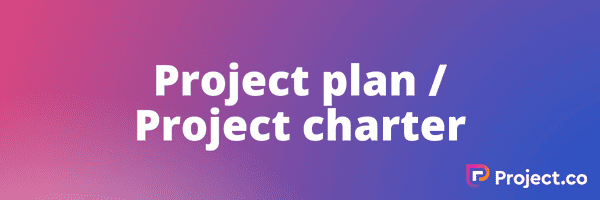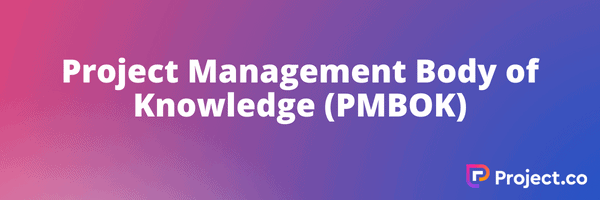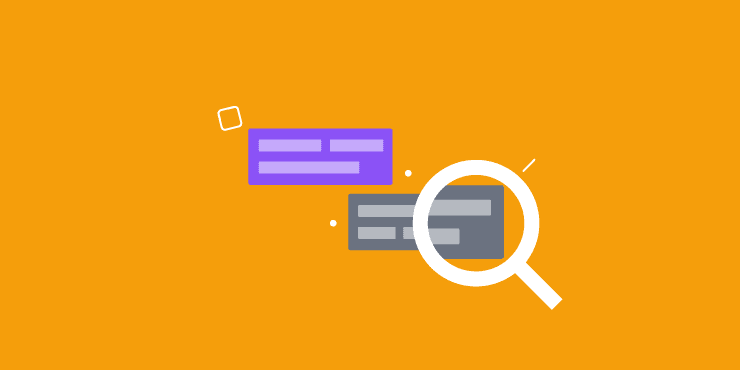Project management is one of those industries that can be super intimidating to enter because of the many buzzwords and project-specific terminology that’s thrown around.
And we all know communication is key for any successful project, so it’s important that everyone involved is on the same page and speaking the same language.
Enter our project management glossary!
In this glossary – true to our mission of simplifying project management for everybody – we’ll demystify the 20 most important and widely used project management terms, so that you know exactly what they mean.
Let’s jump in…
1. Project plan/Project charter

A project plan or charter is a document that officially starts a project and provides an overview of its goals, objectives, and deliverables. It’s a pretty formal document that generally includes milestones, tasks, and deadlines. It’ll also generally define roles and responsibilities, as well as set expectations.
Without a project management plan or charter, it can quickly become more difficult to coordinate all the different aspects of a project and keep everybody accountable throughout the process.
2. Project scope

Project scope is the size, extent, and nature of work to be completed during a project. Scope generally defines the project management processes, deliverables, and project activities.
It’s often confused with schedule or timeline, but it’s important to remember that scope refers to what work needs to be done – while schedule and timeline refer to when it needs to be done.
3. Scope creep

Scope creep describes a project changing or ‘creeping’ over time, beyond what was originally agreed upon. This can lead to projects going over budget, missing deadlines, and ending up with lower project quality outcomes.
Scope creep can happen for a variety of reasons, but is often the result of poor planning or inadequate communication between the project manager and the client.
4. Critical path method

‘Critical path’ may sound like a bad daytime hospital drama, but it’s actually about the order in which tasks need to be completed.
The critical path method dictates that each task must be completed before the next one can begin. It’s represented as a diagram that shows the order of tasks and their dependencies. The length of each arrow represents the amount of time needed to complete the task.

It’s called ‘critical path’ because it’s the longest path through the diagram, which represents the minimum amount of time needed to complete the project.
5. Work breakdown structure (WBS)

Work breakdown structures are important tools that help project managers and teams to break down large projects into smaller, more manageable tasks.
6. Resource allocation

Resource allocation is the process of assigning resources to tasks. This includes human resources, material resources, and financial resources. The goal of resource allocation is to ensure that the project is completed on time and within budget.
‘There are a couple of different ways to approach resource allocation. The most common is to start with a list of all the tasks that need to be completed, and then assign resources to each task based on its importance or urgency.
You might also do it the other way around – start with a list of all the available resources, and then match them up with the tasks that need to be completed.
7. Project life cycle

The project lifecycle (sometimes called project management life cycle) is a fancy name to describe the process that a project goes through from start to finish. There are four main stages in the classic project lifecycle: initiation, planning, execution, and closure.
8. Project management tool

Project management tools (like Project.co) are used to help manage and monitor projects. There are a variety of project management tools available, each with its own set of features and benefits.
9. Earned value management

Earned value management (EVM) is a project management technique that allows you to track the progress of your project in terms of its budget. This is done by multiplying the completion percentage of a project by the total cost of the project to find out what your project’s earned value is. When used correctly, EVM can help you complete your project on time and within budget.
10. Contingency plan

A contingency plan is a key part of any project manager’s toolkit. It’s a plan that outlines how to deal with unexpected events or risks that could impact the success of a project.
11. Change management

Change management is a process that project managers use to deal with changes to the scope, timeline, or other aspects of a project.
Change management includes four main phases:
2. Assessment of impact
3. Control of changes
4. Communication of changes
12. Key performance indicators

Most people are familiar with the idea of key performance indicators (KPIs) in different industries. But specifically in a project management context, KPIs are measures that help you track and assess project progress.
13. Triple Constraint

The triple constraint is one of the most important project management terms to be aware of. It refers to the three main factors that can have an impact on the success of a project: time, cost, and scope.
All three of these factors need to be managed carefully in order to ensure the success of the project.
14. Burndown Chart

A burndown chart is a graphical representation of work remaining versus time. It’s used to track the progress of a project and identify any potential problems that may arise.

Burndown charts are a valuable tool for project managers because they provide a clear picture of progress and can help identify potential issues early on.
15. Kanban

Kanban is a popular project management technique that can be used in a variety of ways to help improve efficiency and coordination. Work is divided into small pieces (called “cards”) and each card is assigned to a specific person.

As work is completed, the cards are moved from one person, team or status to the next until the project is finished.
16. Sprint

Sprint is a project management term that refers to a set period of time during which a specific set of tasks or a goal must be completed. Sprints are particularly well suited to ‘iterative’ undertakings like software projects because they allow for a more agile approach to development.
With Sprints, teams can iterate more quickly and respond to feedback more effectively. This makes for a more efficient and effective development process overall.
17. Agile project management

Agile project management is an iterative and incremental approach to managing projects. This means that instead of trying to do everything all at once, you break the project down into smaller pieces and work on them one at a time, allowing you to make changes and adapt as you go, instead of having to stick to a set plan.
18. Project Management Body of Knowledge

The Project Management Body of Knowledge (PMBOK) is a comprehensive guide that outlines best practices, processes, and tools for managing projects effectively. It’s a collection of standard terminology and guidelines for project management developed by the Project Management Institute (PMI) – so many acronyms!
The PMBOK is designed to be a framework that can be applied to any type of project, regardless of its size or complexity. It’s based on the knowledge and experience of project management professionals around the world and provides a standardised approach to managing projects.
19. Risk management

In project management, risks are events that could mess up the project, like delays, cost overruns, or changes in requirements. Risk management is the process of identifying these risks and figuring out how to deal with them before they become a problem.
20. Stakeholder management

Stakeholders are people who have an interest in your project, like clients, team members, suppliers, and regulators. Stakeholder management is the process of making sure you keep all these people happy by understanding their needs and concerns, and communicating with them regularly.
Final thoughts
Every industry has its own jargon and buzzwords and, in some ways, it’s important to keep on top of this and be able to speak the lingo.
But in another sense, project management can be much more simple than people so often make it: it’s about managing people, teams, projects and tasks.
We built our project management software tool to help you do all this without the fuss. Take it for a test drive today and get ready for project management made simple!







